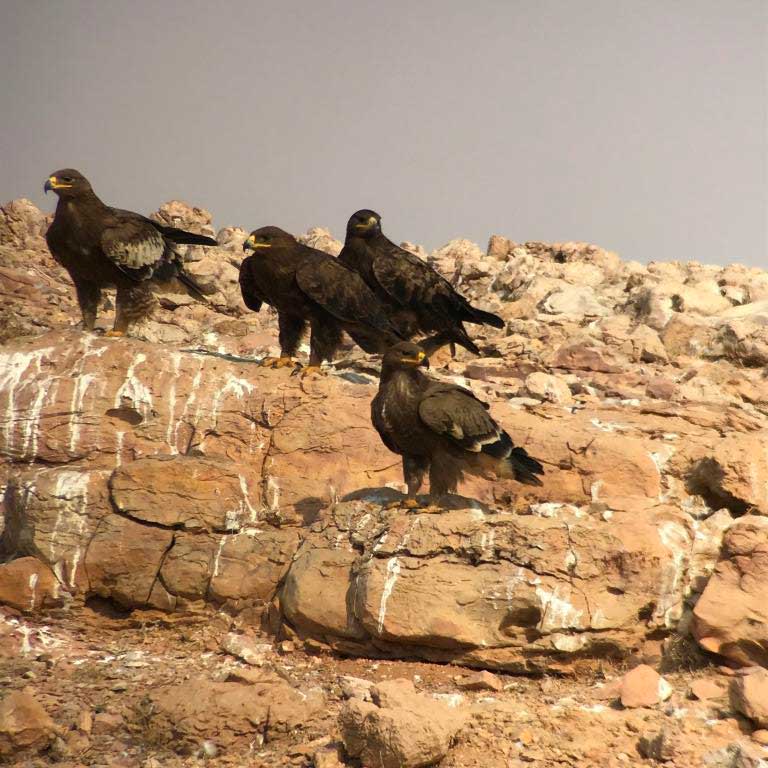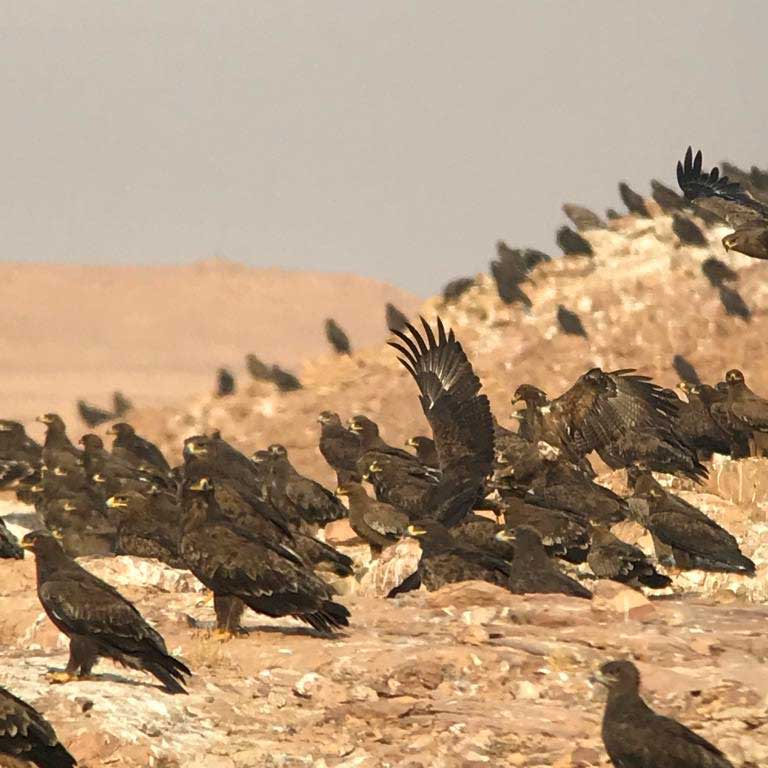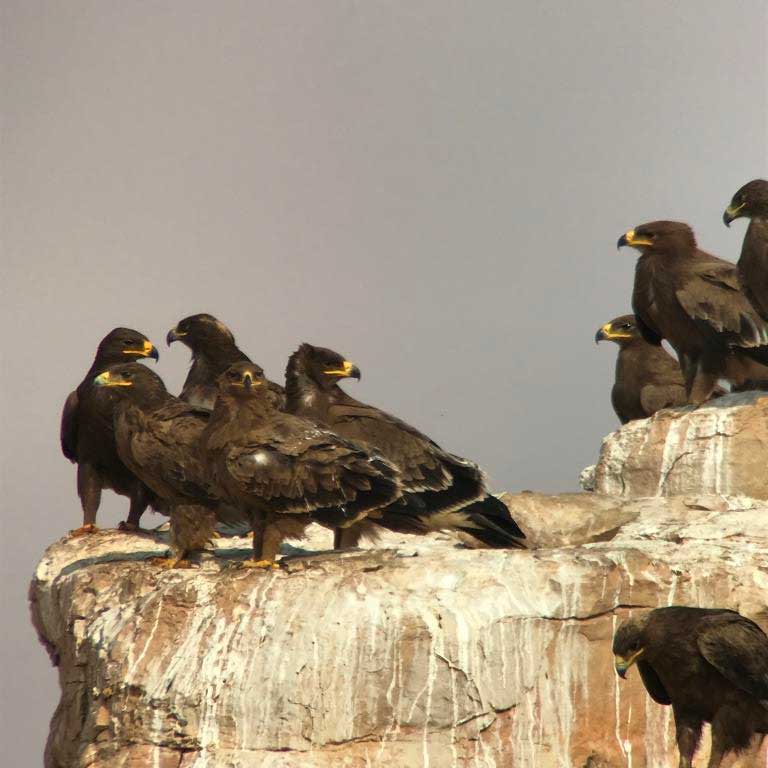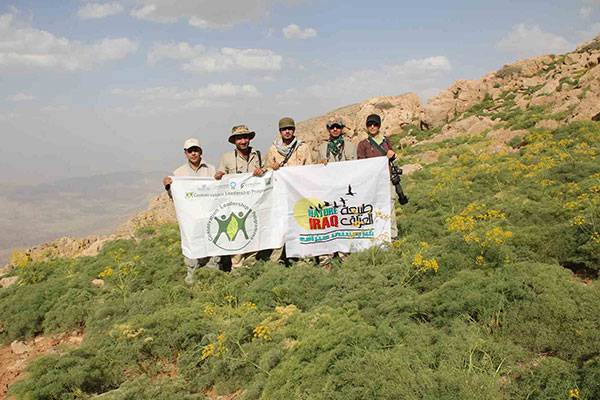
Guest blog by Mischa Keijmel
This article is written following the sighting of large aggregations of Steppe Eagles Aquila nipalensis at dump sites north-west of Riyadh, Saudi Arabia. The area was suspected to be important because a large proportion of Steppe Eagles fitted with satellite tags in Oman by Mike Mc Grady and colleagues passed through or wintered at locations in central Saudi Arabia near the town of Shaqra. To confirm this, a request for observations was passed on to Ian Harrison who posted several messages on the OSME Yahoo discussion forum (OSMEBirdNet) in October 2019. I visited two sites on the 8th and 9th November, resulting in the observation of approximately 4,900 Steppe Eagles aggregating at one of the sites.
The two locations identified by the Oman team are household waste collection sites located 9 km south-west of Shaqra (25.162018°N, 45.195724°E) and 6.5 km south-west from Ushaiqer (25.303000°N, 45.125000°E). The distance between the 2 sites is 17 km. Travel distance from the Riyadh northern ring road is approximately 200 km.
I visited the Shaqra site in the early morning of the 8th where I counted 70 eagles on the pylons of the overhead power transmission lines near the site. All appeared to be Steppe Eagles. The visit was cut short because access to the fenced off disposal site was denied. I did not pursue this opportunity any further, knowing that the Ushaiqer site was still on the list. At the Shaqra site there are possible good vantage points from a ridge to the east, and there is a sandy track around the fence. Future efforts will be made to make observations and counts.
An hour later I arrived at the Ushaiqer site and spent the late morning, and all of the following morning counting and observing eagles. This waste collection site is at the end of a 5 km graded track that splits off from the road between Shaqra and Ushaiqer. Along the first 3.5 km, the surroundings are slightly undulating, barren plains covered with small rocks and devoid of vegetation. In this landscape, observations of large birds such as eagles can be made over several kilometers distance. Afterwards, ridges and small wadis dominate the surroundings, and birds can easily be hidden from sight.
The plains were mostly empty in the first 1.5 km. Further along the route individual eagles were scattered across the plains and on the embankment alongside the track. Most were on the ground and totaled not more than 100. Those close enough for identification were all Steppe Eagles. The actual waste site is inside a depression and not visible until one is more than 4 km down the track. However, from 3 km onwards, one can see congregations of many hundreds of eagles on the many ridges east of the waste site. Only a small fraction (approximately 100 individuals) were airborne. Not until I saw the actual waste site and the surrounding ridges and sandy desert behind, did I comprehend the huge congregation of eagles. Without doing a one-by-one count, I estimated the population at the lower thousands. I do admit that I am not well-practiced at estimating large numbers, and for me everything more than 500 is a lot! Still, numbers in the lower thousands seemed reasonable to me at the time.

Slightly overwhelmed and running out of time I scanned the eagles that were within sight with my telescope, and took photographs of the most common morphs. Photos were made with a scope and iPhone combination. Except for two Eastern Imperial Eagles Aquila heliaca, all of the few hundred birds that I looked at in detail were Steppe Eagles of various ages.
Once back in Riyadh, I informed Mike Mc Grady and Jem Babbington and sent them some photos, and my rough estimate of numbers. They made me understand the significance of this finding, so I returned at dawn the next day. This time I counted all eagles all the way from the start of the track to the waste dump and up to the horizon beyond. The one-by-one count resulted in a tally of 4,420 eagles. Because of the early hour, disturbance was minimal and less than 100 were airborne. I estimate the accuracy of my counts at +/- 10%. I checked the back of 2 ridges that were accessible by car and counted another 500 eagles. The latter is a rough estimate as I had to keep driving to prevent them from taking off. Thus, the total number encountered was approximately 4,920. I scanned for eagle species other than A. niplaensis and noticed the 2 Eastern Imperial Eagles were still present. I recorded one juvenile Greater Spotted Eagle (Clanga clanga). All of the other few hundred birds that I looked at in more detail were Steppe Eagles. Of those, about 65% had the adult (5-6+ years old) dark brown plumage. The remaining 35% were in juvenile and sub-adult plumages with the typical light brown bands in the wings. Aging of birds in flight resulted in more or less similar ratios.
Although I don’t have a comprehensive knowledge of all observations of eagle concentrations, this is the largest of which I am aware, and many times larger than the vast majority of observations.
This is a truly amazing site with an astonishing number of Steppe Eagles, which if global estimates are to be believed, represents a very significant portion of the world population. A local from Ushaiqer pointed out that there is another eagle congregation, although smaller, 4 km to the north, and Mike Mc Grady also indicated that satellite tracking data suggests that there are possibly more concentrations in the surrounding area. Further, I don’t want to rule out the possibility that the Shaqra site might hold many eagles. Although less accessible, a second visit may reveal more. Sites like these emphasize the importance of “Dine Inns” along the migration routes and made me appreciate garbage a lot more. I want to thank Mike and his team for sharing these coordinates and also providing information for this article. Finally, I want to invite more birders to visit the sites and collect supporting data. I will definitely keep a close eye on these sites in the time to come.

About Mischa Keijmel

Mischa Keijmel has lived in the Middle East for more than 10 years and currently lives in Riyadh. He has been a keen naturalist for most of his life, but took up serious birding only 10 years ago. His favourite spots in Saudi are Wadi Haeer (Riyadh) and southern Asir mountains. Anywhere in Oman or the nearby Caucasus are also favoured locations in the OSME region.
Steppe Eagle: The global context
As recently as 30 years ago the Steppe Eagle was the most populous breeding eagle species of Northern Eurasia. However, its numbers have declined by nearly 60% during the period 1997 – 2015. Currently, Steppe Eagle has disappeared from much of its breeding range, including most parts of Eastern Europe, the Caucasus and Urals; it is currently regarded an Endangered species by the IUCN. Relative strongholds on the breeding grounds are confined to the steppe region of mainly Kazakhstan, Russia and Mongolia, where its ability to nest on the ground allows it to inhabit plains, mountains, deserts and tundra in the steppe zone. From these breeding grounds, winter migration routes lead to southern Eurasia, the Arabian Peninsula and northeastern, eastern and southern Africa. The global population is estimated at 50,000 – 75,000 mature individuals, with the largest population breeding in Kazakhstan.
In order to gather more information on Steppe Eagle movements and survival that might be used to conserve them, several tagging and tracking programmes have been initiated. Since 2017, M. Mc Grady et al. have been tracking Steppe Eagles captured at their wintering sites in Muscat and Salalah, Oman, and have tracked them all the way to their breeding grounds in Kazakhstan. Observations from this programme showed that two eagles returning from their breeding grounds spent two subsequent winters at rubbish sites in central and southwestern Saudi Arabia. Suspicion was raised that major wintering sites or migration stop-overs exist in central Saudi Arabia, and that they may play an important part in Steppe Eagle migration and in providing wintering locations with abundant food.
References and useful reading
M. Mc Grady, A. Spalton, F. Al Lamki and B.-U. Meyburg : http://steppeeaglesoman.blogspot.com/
BirdLife International – species factsheet: Steppe Eagle Aquila nipalensis http://datazone.birdlife.org/species/factsheet/steppe-eagle-aquila-nipalensis
Russian raptor Research and Conservation Network http://rrrcn.ru/en
Photo credit: all photos are copyright Mischa Keijmel



Outstanding article… wonderful photos